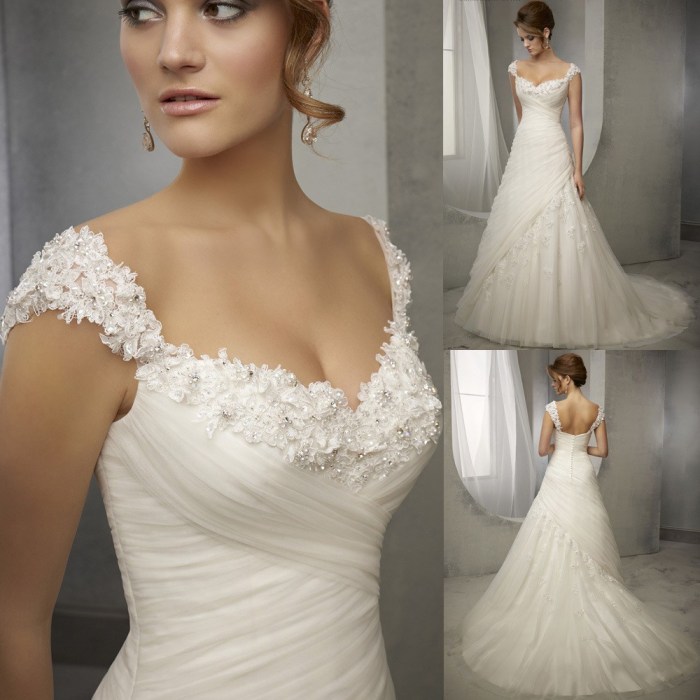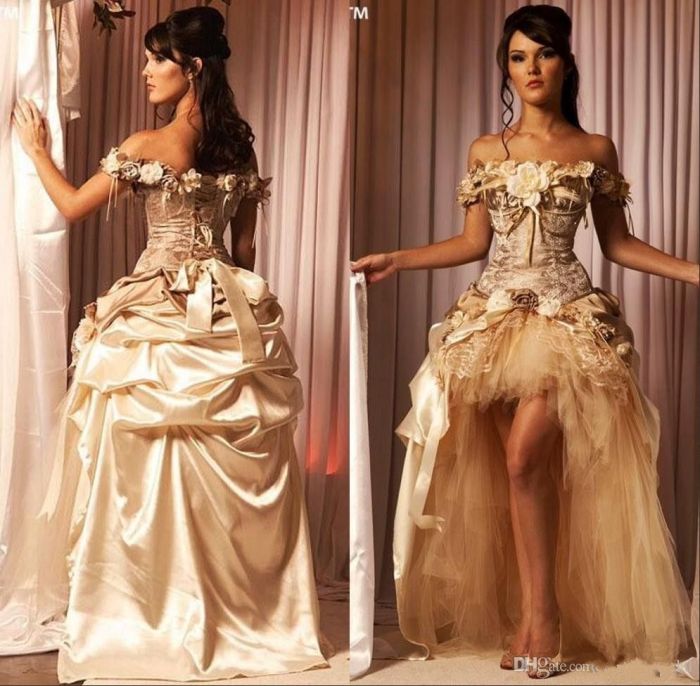Vintage Country Wedding Dresses A Timeless Elegance
Vintage Country Wedding Dresses: A Timeless Elegance
Vintage country wedding dresses evoke a sense of rustic charm and romantic nostalgia. They represent a unique blend of classic silhouettes and handcrafted details, reflecting the fashion trends and cultural influences of bygone eras. This exploration delves into the defining characteristics, popular styles, and enduring appeal of these captivating gowns.
Defining “Vintage Country Wedding Dresses”
A vintage country wedding dress transcends a simple “country” aesthetic. It encompasses gowns from approximately the 1920s to the 1990s, characterized by a blend of romantic and rustic elements. These dresses often feature natural fabrics, softer silhouettes compared to their more structured city counterparts, and embellishments that reflect the craftsmanship of the era. Key differences from modern country dresses lie in the fabric choices (more emphasis on natural fibers like cotton and linen in vintage styles), the silhouettes (vintage dresses often have more defined waists and less emphasis on layers or volume), and the embellishments (vintage details tend to be more handcrafted and less mass-produced).
Popular Fabrics and Silhouettes
The fabrics and silhouettes of vintage country wedding dresses varied across decades, reflecting the prevailing fashion trends. Common fabrics included cotton, linen, lace, and sometimes silk, depending on the era and the bride’s budget. Silhouettes ranged from the loose, flowing styles of the 1920s to the more fitted, A-line shapes of the 1950s and the empire waists popular in the 1970s and 80s.
| Decade | Common Fabric | Typical Silhouette | Distinguishing Features |
|---|---|---|---|
| 1920s-1930s | Cotton, Lace, Silk | Loose, Dropped Waist, Flowing | Beaded embellishments, delicate lace, often featuring a cloche hat. |
| 1940s-1950s | Linen, Cotton, Silk | Fitted Bodice, Full Skirt, A-line | Simple elegance, often with a cinched waist, possibly featuring puffed sleeves or a sweetheart neckline. |
| 1960s-1970s | Cotton, Lace, Eyelet | Empire Waist, A-line, Maxi Length | Floral prints, embroidery, often with a more bohemian feel. |
| 1980s-1990s | Lace, Satin, Tulle | Puffed Sleeves, Ruffle Details, A-line or Ballgown | Romantic details, lace, often incorporating elements of the Victorian era. |
Lace and Embellishments

Source: alicdn.com
Lace played a significant role, adding both texture and visual interest. Different types of lace, such as Alençon, Chantilly, and Irish crochet, were used, each with its unique pattern and feel. Beading, embroidery (often floral motifs), and delicate pearl accents were common embellishments, enhancing the overall romantic aesthetic.
Sketch 1: A 1920s-inspired gown with delicate Alençon lace cascading down the back and sleeves, complemented by subtle beading around the neckline. The silhouette is loose and flowing, reflecting the era’s relaxed elegance.
Sketch 2: A 1950s-inspired A-line dress with intricate floral embroidery adorning the bodice and extending to the skirt’s hem. The embroidery uses a variety of stitches and threads, adding depth and texture. The waist is cinched for a feminine silhouette.
Sketch 3: A 1970s-inspired empire waist gown featuring eyelet lace panels along the bodice and sleeves. The lace is combined with simple cotton fabric, creating a relaxed, bohemian look. The skirt flows freely, adding to the gown’s overall ethereal quality.
Color Palettes and Trends

Source: gemgrace.com
Color choices reflected the prevailing fashion sensibilities of each era. The 1920s and 30s saw ivory and cream shades, often with subtle pastel accents. The 1940s and 50s favored classic white, sometimes with touches of blush pink or ivory. The 1960s and 70s introduced a wider range of colors, including soft yellows, blues, and even muted floral prints.
The 1980s and 90s continued the trend towards ivory and off-white, but with more elaborate lace and embellishments that often incorporated hints of blush or champagne tones.
Accessories and Styling

Source: dhresource.com
Accessories played a crucial role in completing the vintage country wedding look. Veils, often simple and delicate, were common, as were floral headpieces or simple hair combs. Jewelry choices typically leaned towards pearls, delicate necklaces, and understated earrings. Hairstyles ranged from loose waves and finger waves in the earlier decades to more structured updos and braids in later eras.
Makeup was typically soft and natural, enhancing the bride’s features without overwhelming the overall look.
Preservation and Care, Vintage country wedding dresses
Proper preservation is essential for maintaining the beauty and integrity of a vintage country wedding dress. Storing the dress in an acid-free box or garment bag, away from direct sunlight and moisture, is crucial. Professional cleaning and restoration by a specialist experienced in handling vintage textiles is highly recommended to remove stains and prevent damage. Delicate fabrics and embellishments should be handled with care, avoiding harsh chemicals or excessive friction.
Modern Interpretations
Modern designers frequently draw inspiration from vintage country wedding dresses, incorporating elements like lace, embroidery, and natural fabrics into contemporary designs. While modern interpretations may utilize more contemporary silhouettes or incorporate bolder color palettes, they often retain the romantic charm and handcrafted feel of their vintage counterparts.
- Empire waists with modern, flowing fabrics
- Delicate lace overlays on simpler silhouettes
- Floral embroidery on lightweight fabrics
- Bohemian-inspired details, such as crocheted lace
- Natural, organic color palettes with subtle accents
Finding and Purchasing Vintage Dresses
Finding a vintage country wedding dress involves exploring various avenues. Online marketplaces like Etsy and eBay offer a wide selection, while antique shops and vintage boutiques provide a more hands-on experience. Authenticating a vintage dress requires careful examination of the construction, fabrics, and embellishments. Checking for consistent stitching, the quality of the materials, and the presence of period-specific details can help distinguish genuine vintage pieces from modern replicas.
Condition and the dress’s overall rarity are significant factors influencing its value.
Top FAQs: Vintage Country Wedding Dresses
How do I determine the authenticity of a vintage wedding dress?
Examine stitching, fabric quality, and construction techniques. Look for hallmarks of the era, such as specific types of lace or embellishments. Consulting with a vintage clothing expert or appraiser is recommended.
Where can I find vintage wedding dress patterns?
Online marketplaces like Etsy, eBay, and specialized vintage pattern websites are good starting points. Antique shops and vintage clothing stores may also offer patterns or inspiration.
Vintage country wedding dresses often evoke a sense of rustic charm, with their delicate lace and flowing silhouettes. The influence of global styles is evident, and you might find similarities with the vibrant and often uniquely designed south african wedding dresses , which frequently incorporate bold colors and intricate beadwork. Ultimately, the choice between these styles depends on the bride’s personal preference and desired aesthetic for her special day.
What are the common challenges of wearing a vintage wedding dress?
Alterations may be necessary to ensure a proper fit. The dress may require professional cleaning and preservation. The fabric’s age may limit its durability.
How much should I expect to pay for a vintage country wedding dress?
Pricing varies greatly depending on the dress’s age, condition, designer (if any), and fabric. Research comparable dresses to get a general idea of market value.



















